Experimental Investigation of the Output Performance of Compressed-Air-Powered Vehicles with a Pneumatic Motor
Abstract
1. Introduction
2. Experimental Setup and Working Principle
2.1. Test Bench of Experimental Setup
2.2. Working Principle
3. Result and Discussion
3.1. Effect of Rotation Speed on the Output Performance of the PM
3.2. Effect of Torque on the Output Performance
3.3. Comparison of the Output Performance of the PM under Dynamic Conditions
3.4. Relative Error Analysis of Forward and Reverse Rotation of the PM
3.5. Uncertainty Analysis
4. Conclusions and Future Outlook
- (1)
- The effects of rotational speed, torque, and regulated pressure on the power performance, economy, and energy conversion efficiency of the pneumatic motor were investigated. The maximum power output and energy conversion efficiency of the pneumatic motor were about 1220 W and 13.23%, respectively.
- (2)
- The CACR of the PM with forward rotation was lower than that with reverse rotation, indicating that the forward rotation of the PM is more economical than the reverse rotation. The energy conversion efficiency of the PM with forward rotation was greater than that with reverse rotation.
- (3)
- The power output of the PM with forward rotation was greater than that with reverse rotation, indicating that the PM demonstrates better power performance with forward rotation than with reverse rotation.
- (4)
- From the perspective of improving the power output and energy conversion efficiency, the PM should work in the high-torque range as much as possible to ensure good power performance. From the perspective of improving economy, the PM should operate in the high-rotational-speed range.
- (5)
- This study compared and analyzed the power performance, economy, and energy conversion efficiency of PMs under EUDC, highway, Japan, and UDDC conditions.
Author Contributions
Funding
Informed Consent Statement
Data Availability Statement
Conflicts of Interest
Nomenclature
| pin | Intake pressure (bar) |
| pe | Exhaust back pressure (bar) |
| pr | Regulated pressure (bar) |
| P | Power output (W) |
| Tr | Torque (N·m) |
| n | Rotational speed (r/min) |
| m | Mass rate of compressed air (g/s) |
| b | Compressed-air consumption rate (g/J) |
| Greek letters | |
| ε | Expansion ratio |
| η | Energy efficiency |
| Acronyms | |
| CAE | Compressed-air engine |
| CAV | Compressed-air-powered vehicle |
| PM | Pneumatic motor |
| CACR | Compressed-air consumption rate |
References
- Chang, J.; Li, Z.; Huang, Y.; Yu, X.; Jiang, R.; Huang, R.; Yu, X. Multi-objective optimization of a novel combined cooling, dehumidification and power system using improved M-PSO algorithm. Energy 2021, 239, 122487. [Google Scholar] [CrossRef]
- Ibrahim, I.D.; Sadiku, E.R.; Jamiru, T.; Hamam, Y.; Alayli, Y.; Eze, A.A. Prospects of nanostructured composite materials for energy harvesting and storage. J. King Saud Univ.-Sci. 2020, 32, 758–764. [Google Scholar] [CrossRef]
- Xu, Y.; Zhang, H.; Yang, F.; Tong, L.; Yang, Y.; Yan, D.; Wang, C.; Ren, J.; Wu, Y. Experimental study on small power generation energy storage device based on pneumatic motor and compressed air. Energy Convers. Manag. 2021, 234, 113949. [Google Scholar] [CrossRef]
- Marvania, D.; Subudhi, S. A comprehensive review on compressed air powered engine. Renew. Sustain. Energy Rev. 2017, 70, 1119–1130. [Google Scholar] [CrossRef]
- Dižo, J.; Blatnický, M.; Sága, M.; Šťastniak, P. A Numerical Study of a Compressed Air Engine with Rotating Cylinders. Appl. Sci. 2021, 11, 7504. [Google Scholar] [CrossRef]
- Yu, Q.; Hao, X.; Tan, X. Comparative study on air distribution system for piston-type compressed air engine. Adv. Mech. Eng. 2017, 9. [Google Scholar] [CrossRef]
- Sivasubramanian, R.; Kumaresan, G.; Kumar, N.N.; Rajeshwaran, S.; Jeyaseelan, R.; Manikandan, V.; Maran, B.M. Design and analysis of air powered vehicle frame. Mater. Today Proc. 2020, 45, 1366–1370. [Google Scholar] [CrossRef]
- Kumar, S.; Pradhan, P.K.; Khan, Z.H.; Kumar, B.A.; Chaithanya, M. Design and developing of compressed air engine. Int. Res. J. Eng. Technol. (IRJET) 2017, 4, 1468–1474. [Google Scholar]
- Vishnuvardhan, M.; Prasad, K.S.; Purushothaman, J. Design and experimental investigation of compressed air engine. Mater. Today: Proc. 2020, 33, 3311–3313. [Google Scholar] [CrossRef]
- Sabareesan, S.; Kannan, R.; Chandrasekar, G. Design and Fabrication of Compressed Air Engine Technology. MASK Int. J. Sci. Technol. 2016, 1, 21–26. [Google Scholar]
- Pujari, P.C.; Jain, A.; Nath, D.S.; Kumar, N. Designing, modeling, and structural analysis of a newly designed double lobe camshaft for a two-stroke compressed air engine. Mater. Today Proc. 2021, 47, 3392–3399. [Google Scholar] [CrossRef]
- Zhang, X.; Wang, X.; Li, W.; Zhu, Y.; Zuo, Z.; Chen, H. Energy and exergy analysis of compressed air engine systems. Energy Rep. 2021, 7, 2316–2323. [Google Scholar] [CrossRef]
- Nabil, T. Investigation and implementation of compressed air powered motorbike engines. Eng. Rep. 2019, 1, e12034. [Google Scholar] [CrossRef]
- Yu, Q.; Cai, M. Experimental Analysis of a Compressed Air Engine. J. Flow Control. Meas. Vis. 2015, 3, 144–153. [Google Scholar] [CrossRef]
- Yu, Q.; Shi, Y.; Cai, M.; Xu, W. Fuzzy logic speed control for the engine of an air-powered vehicle. Adv. Mech. Eng. 2016, 8, 1–11. [Google Scholar] [CrossRef]
- Zeng, F.; Xu, J. Study on exergy analysis of a compressed air engine. Therm. Sci. 2018, 22, 1179–1191. [Google Scholar] [CrossRef]
- Zeng, F.; Xu, J. Theoretical and experimental research on the port timing of a compressed air engine. Energy Sources Part A Recover. Util. Environ. Eff. 2019, 44, 4888–4901. [Google Scholar] [CrossRef]
- Wasbari, F.; Bakar, R.; Gan, L.; Tahir, M.; Yusof, A. A review of compressed-air hybrid technology in vehicle system. Renew. Sustain. Energy Rev. 2017, 67, 935–953. [Google Scholar] [CrossRef]
- Fang, Y.; Lu, Y.; Roskilly, A.P.; Yu, X. A review of compressed air energy systems in vehicle transport. Energy Strat. Rev. 2021, 33, 100583. [Google Scholar] [CrossRef]
- Xu, Y.; Zhang, H.; Yang, F.; Tong, L.; Yan, D.; Yang, Y.; Wang, Y.; Wu, Y. Experimental investigation of pneumatic motor for transport application. Renew. Energy 2021, 179, 517–527. [Google Scholar] [CrossRef]
- Uszyński, S.; Ambroziak, L.; Kondratiuk, M.; Kulesze, Z. Air consumption analysis in compressed air powered vehicles. In Proceedings of the 2018 23rd International Conference on Methods & Models in Automation & Robotics (MMAR) IEEE, Miedzyzdroje, Poland, 27–30 August 2018; pp. 837–842. [Google Scholar]
- Alami, A.H.; Alblooki, N.; Tawalbeh, M.; Almerashi, Z.; Alkharousi, A.; Salameh, T. Compressed air for light vehicle propulsion. In Proceedings of the 2020 Advances in Science and Engineering Technology International Conferences (ASET) IEEE, Dubai, United Arab Emirates, 4 February–9 April 2020; pp. 1–6. [Google Scholar]
- Ramasubramanian, S.; Chandrasekaran, M.; Baskar, S.; Dowhithamaran, A. Ravin Design and development of pneumatic compressed air vehicle. Mater. Today Proc. 2020, 37, 690–693. [Google Scholar] [CrossRef]
- Giradkar, A.D.; Ade, N.K. Design and Testing of Compressed Air Vehicle. Int. J. New Technol. Res. 2018, 4, 03–06. [Google Scholar]
- Radhika, S.; Swapna, D.; Manikanta, P.; Sunain, S.K. Design of a compressed air vehicle. J. Refrig. Air Cond. Heat. Vent. 2016, 1, 1–6. [Google Scholar]
- Teli, S.N.; Chari, K.S.; Yadav, K.; Pawar, A. Design of Pneumatically Powered Bicycle. In Proceedings of the International Conference on Recent Advances in Computational Techniques (IC-RACT) 2020, Navi Mumbai, India, 26–27 June 2020. [Google Scholar]
- Shi, Y.; Wu, T.; Cai, M.; Wang, Y.; Xu, W. Energy conversion characteristics of a hydropneumatic transformer in a sustainable-energy vehicle. Appl. Energy 2016, 171, 77–85. [Google Scholar] [CrossRef]
- Evrin, R.A.; Dincer, I. Experimental investigation of a compressed air vehicle prototype with phase change materials for heat recovery. Energy Storage 2020, 2, e159. [Google Scholar] [CrossRef]
- Shi, Y.; Wang, Y.; Liang, H.; Cai, M. Power characteristics of a new kind of air-powered vehicle. Int. J. Energy Res. 2016, 40, 1112–1121. [Google Scholar] [CrossRef]
- Alami, A.H.; Abu Hawili, A.; Fadel, M.I.; Zwayyed, F.; Barbarji, T.; Ghommem, M. Technical feasibility of a pneumatically driven vehicle. Sci. Total Environ. 2021, 757, 143937. [Google Scholar] [CrossRef]
- Zhi, R.; Lei, B.; Zhang, C.; Ji, W.; Wu, Y. Experimental study of single screw expander with different oil-gas separators in compressed air powered system. Energy 2021, 235, 121371. [Google Scholar] [CrossRef]
- Evrin, R.A.; Dincer, I. Energy and exergy analyses of experimental compressed air vehicle prototype with heating element. Int. J. Exergy 2021, 35, 471–483. [Google Scholar] [CrossRef]
- Simon, M.; Simon, M.I. New research and design to obtain a compressed air driven prototype vehicle. Procedia Manuf. 2020, 46, 454–460. [Google Scholar] [CrossRef]
- Wang, L.; Zhu, S.-L.; Zhang, X.-R.; Zhang, H.-Y. Another way of cleaner public transportation: Four-stroke high torque CAE (Compressed Air Engine) performance analysis and CAE bus. Energy Rep. 2022, 8, 5727–5738. [Google Scholar] [CrossRef]
- Karaca, A.E.; Dincer, I.; Nitefor, M. Development of an integrated solar and wind driven energy system for desalination and power generation. Sustain. Energy Technol. Assess. 2022, 52, 102249. [Google Scholar] [CrossRef]
- Karaca, A.E.; Dincer, I. A Hybrid Compressed Natural Gas-Pneumatic System as a Powering Option for Buses: A Comparative Assessment. Energy 2021, 230, 120865. [Google Scholar] [CrossRef]
- Karaca, A.E.; Dincer, I.; Nitefor, M. Analysis of a newly developed hybrid pneumatic powertrain configuration for transit bus applications. Energy 2022, 248, 123557. [Google Scholar] [CrossRef]
- Al-Zareer, M.; Dincer, I.; Rosen, M.A. Development and analysis of a portable compressed liquid air cooling system for fast vehicle cabin cooling. Int. J. Refrig. 2017, 84, 117–127. [Google Scholar] [CrossRef]
- Brown, T.; Atluri, V.; Schmiedeler, J. A low-cost hybrid drivetrain concept based on compressed air energy storage. Appl. Energy 2014, 134, 477–489. [Google Scholar] [CrossRef]
- Zeynali, S.; Rostami, N.; Ahmadian, A.; Elkamel, A. Robust multi-objective thermal and electrical energy hub management integrating hybrid battery-compressed air energy storage systems and plug-in-electric-vehicle-based demand response. J. Energy Storage 2021, 35, 102265. [Google Scholar] [CrossRef]
- Doosti, R.; Sedighizadeh, M.; Sedighizadeh, D.; Fini, A.S. Robust stochastic optimal operation of an industrial building including plug in electric vehicle, solar-powered compressed air energy storage and ice storage conditioner: A case study in the city of Kaveh, Iran. IET Smart Cities 2022, 4, 56–77. [Google Scholar] [CrossRef]
- Ghazvini, A.; Sedighizadeh, M.; Olamaei, J. Semidefinite programing as a tool for economic-environmental operation of a microgrid including compressed air energy storage and electric vehicle. J. Energy Storage 2021, 43, 103215. [Google Scholar] [CrossRef]
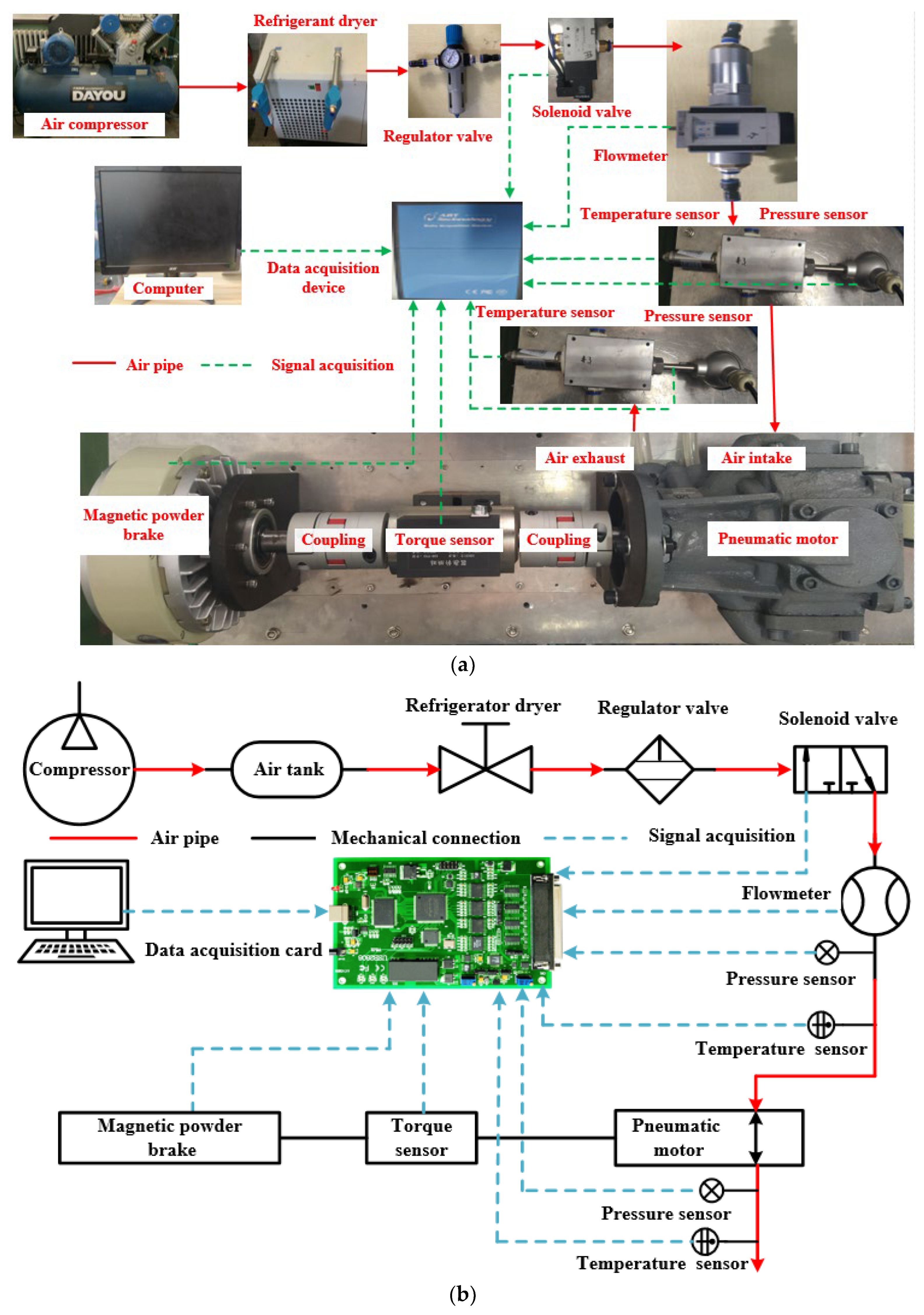
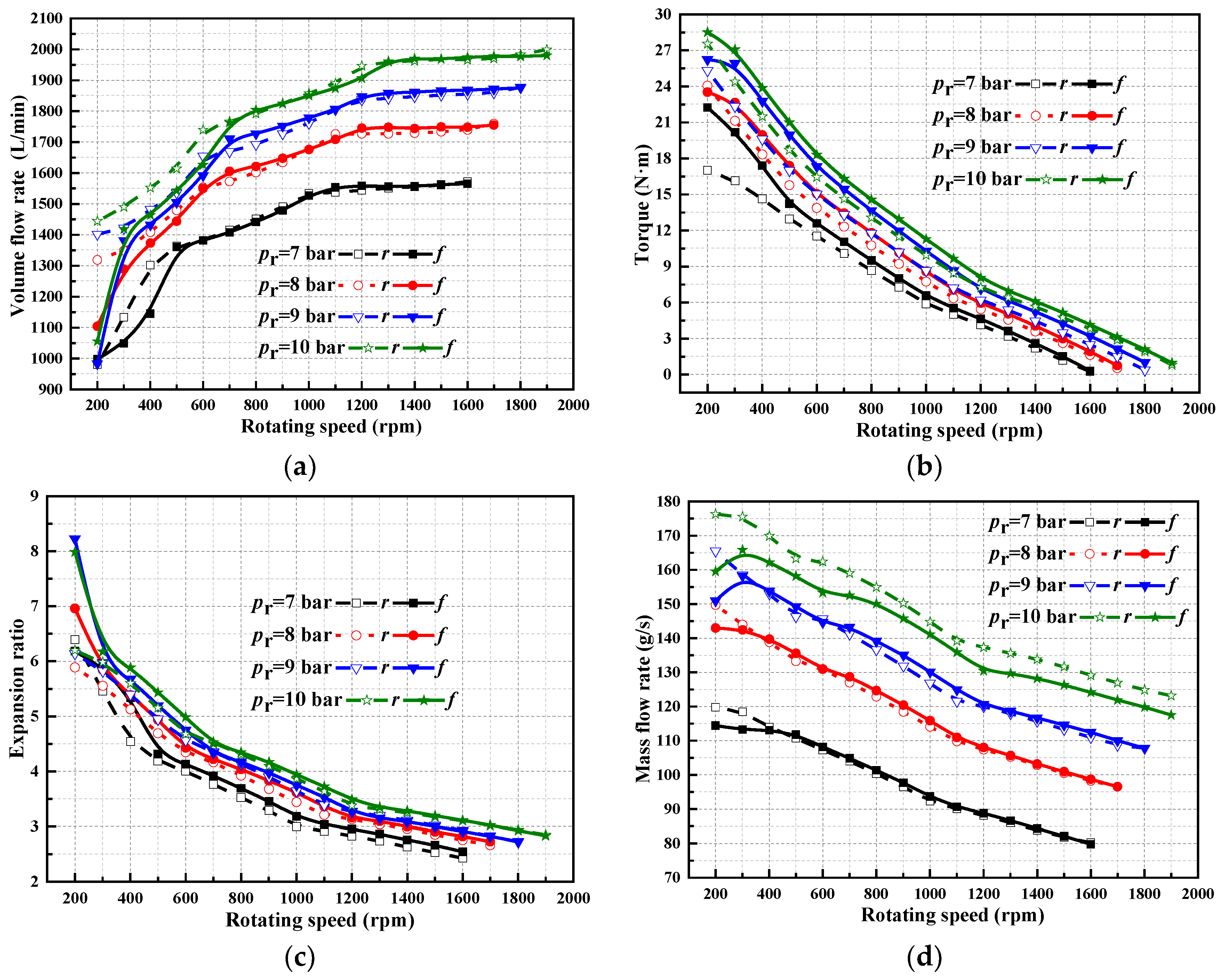
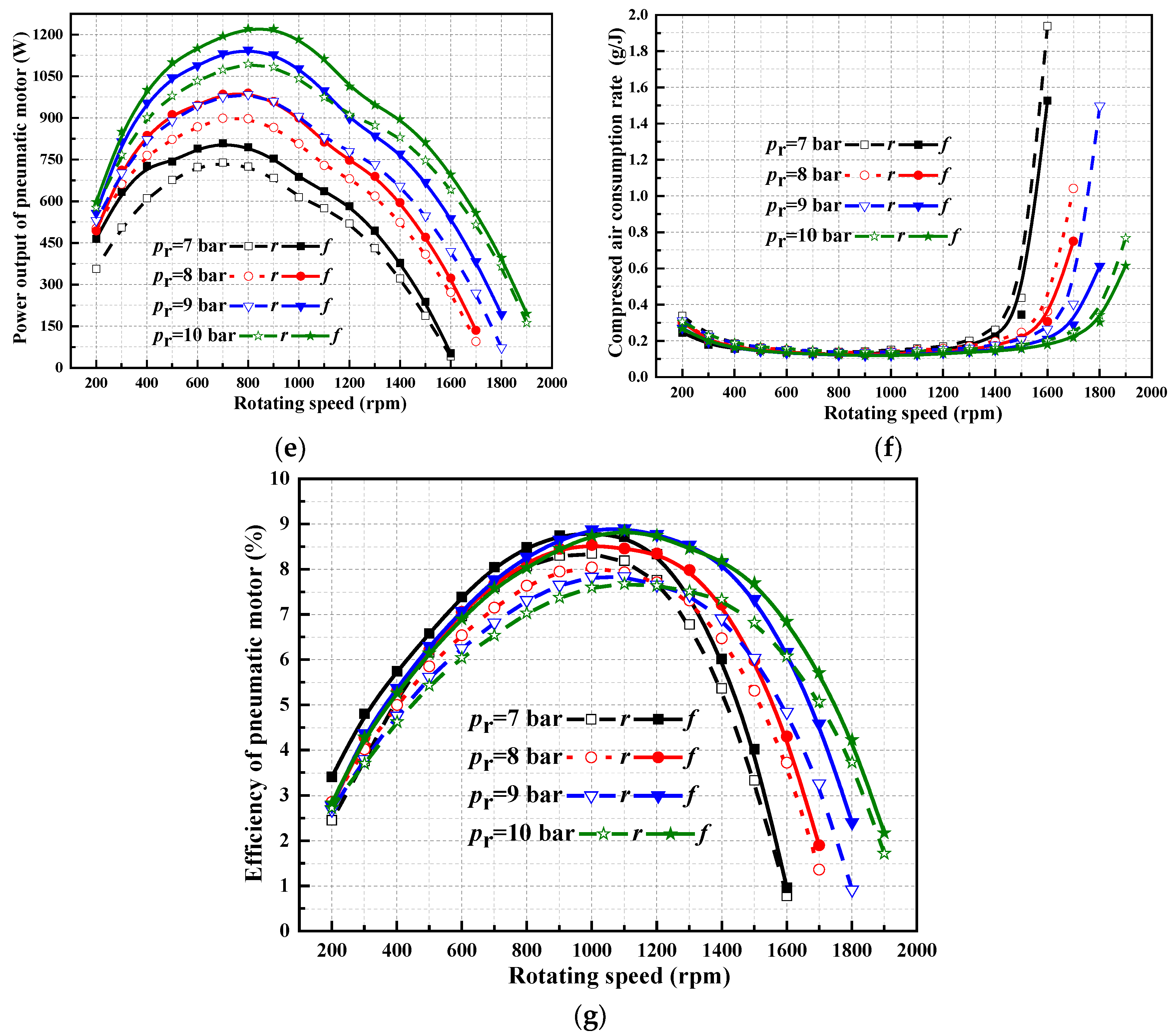


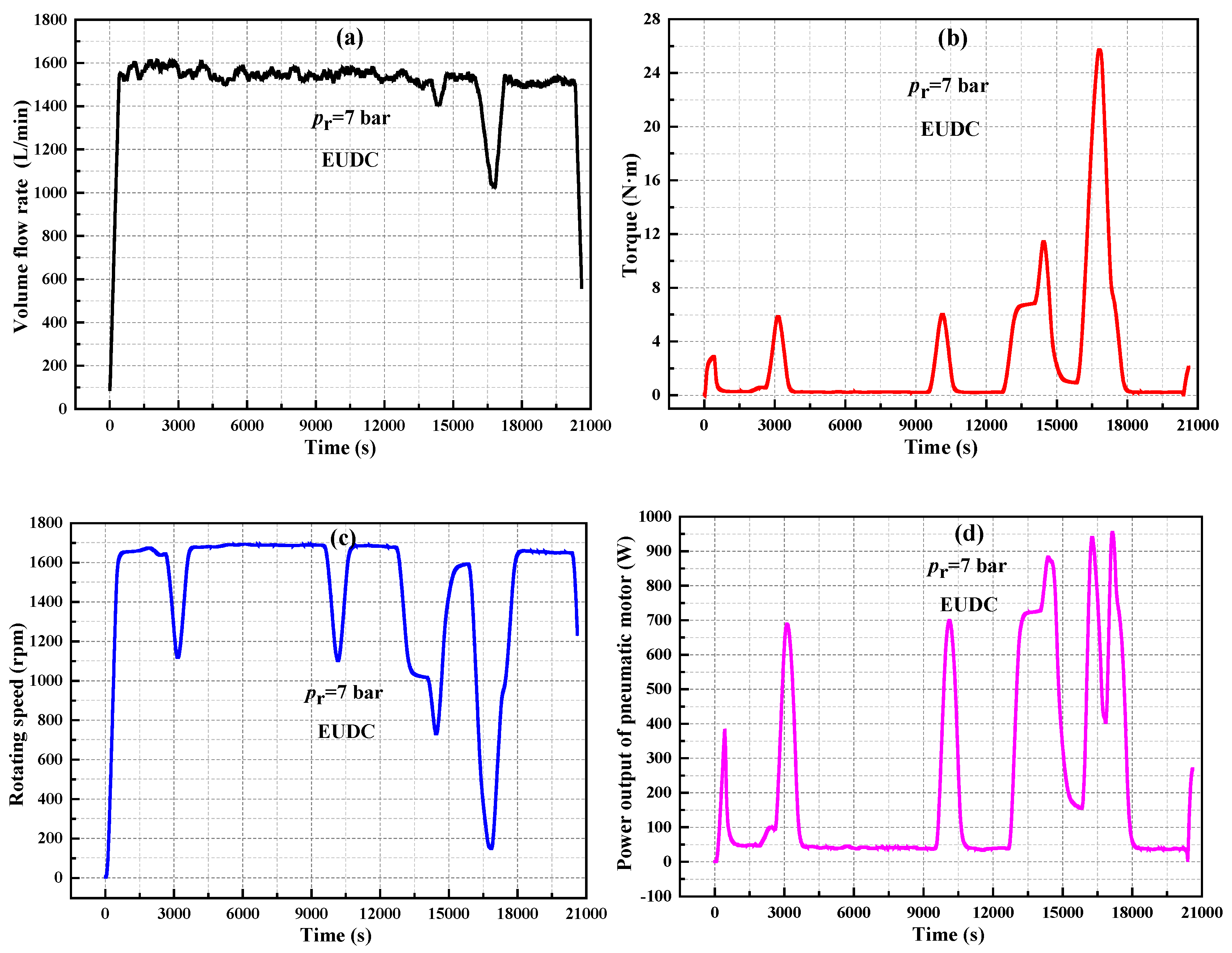
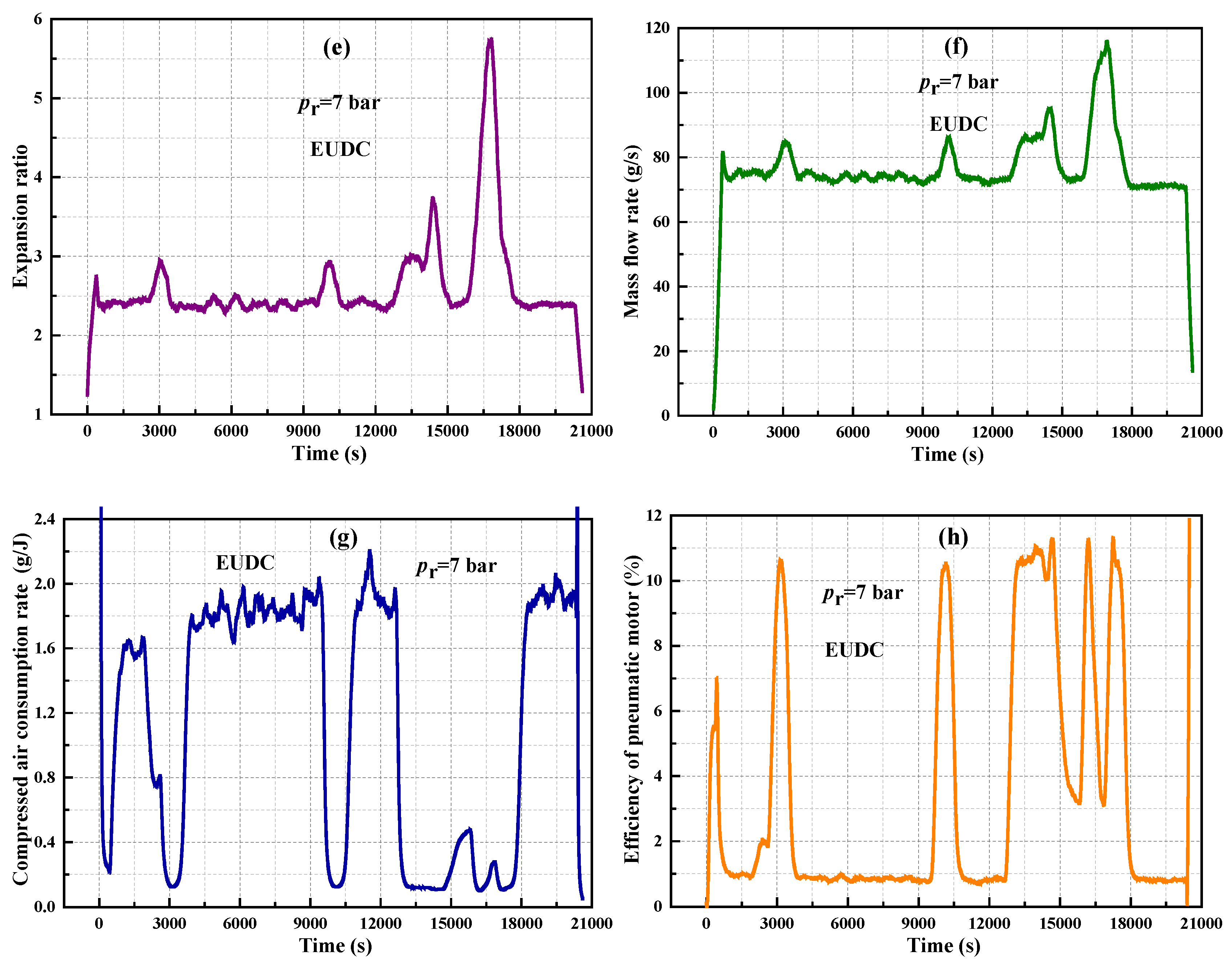

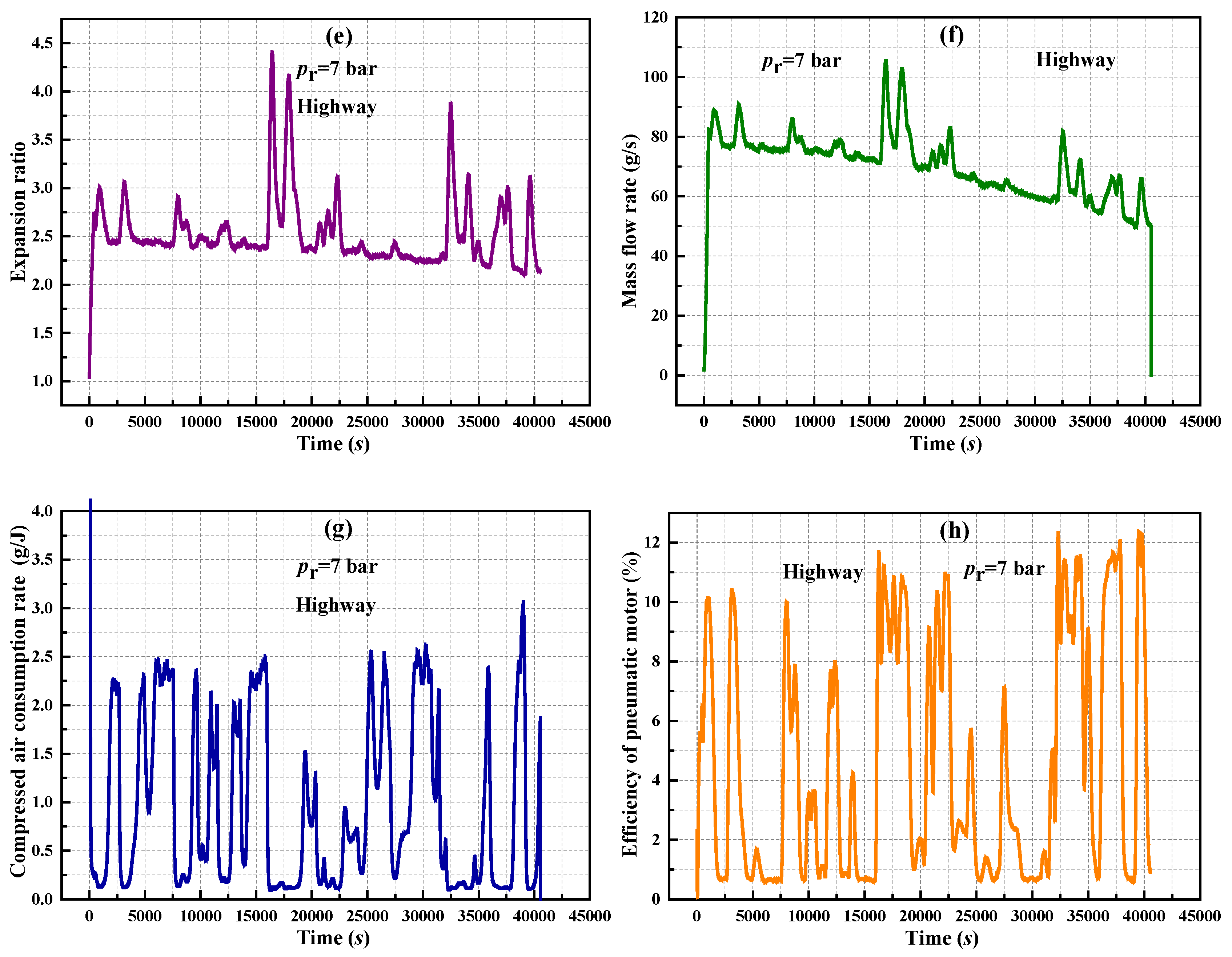



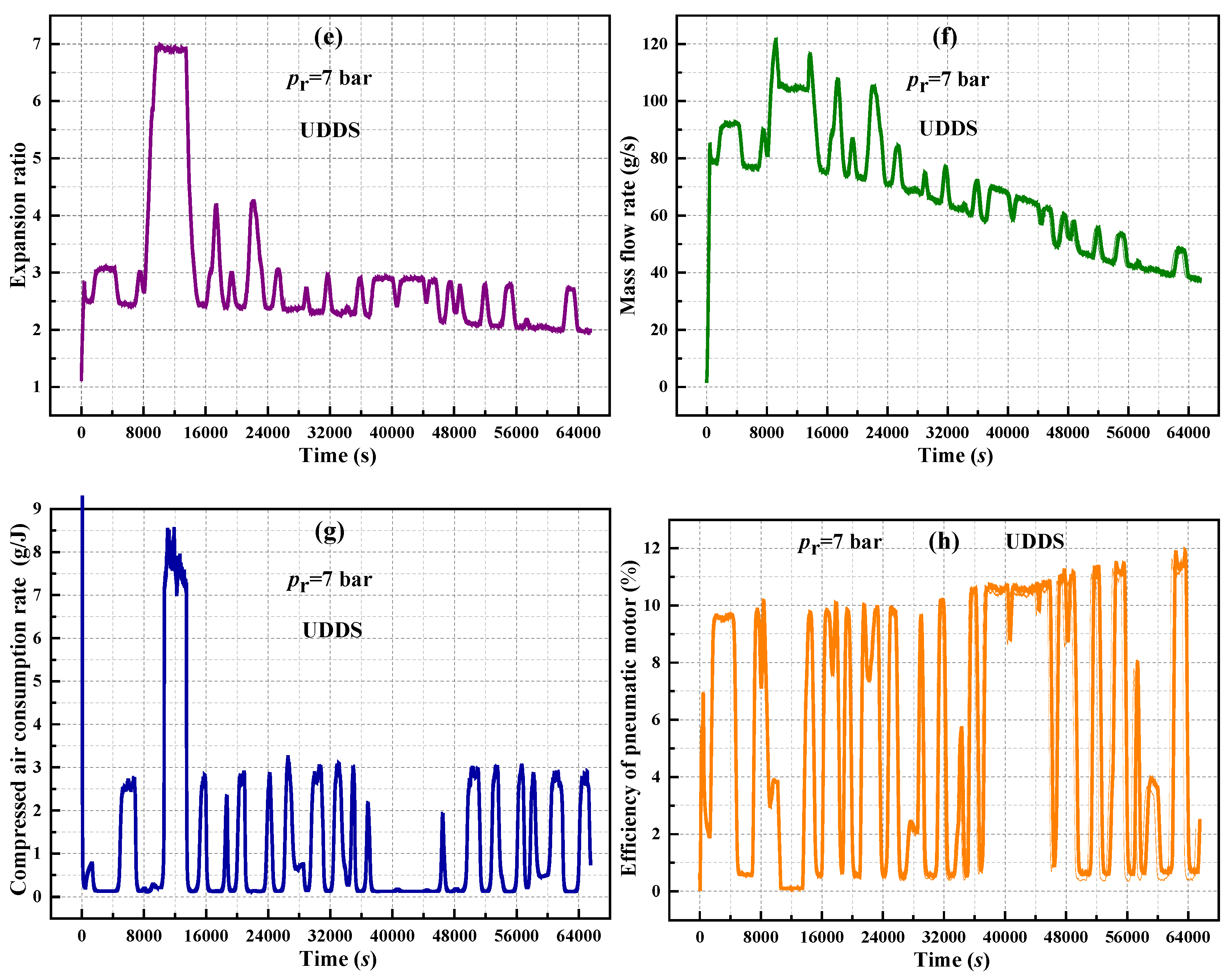
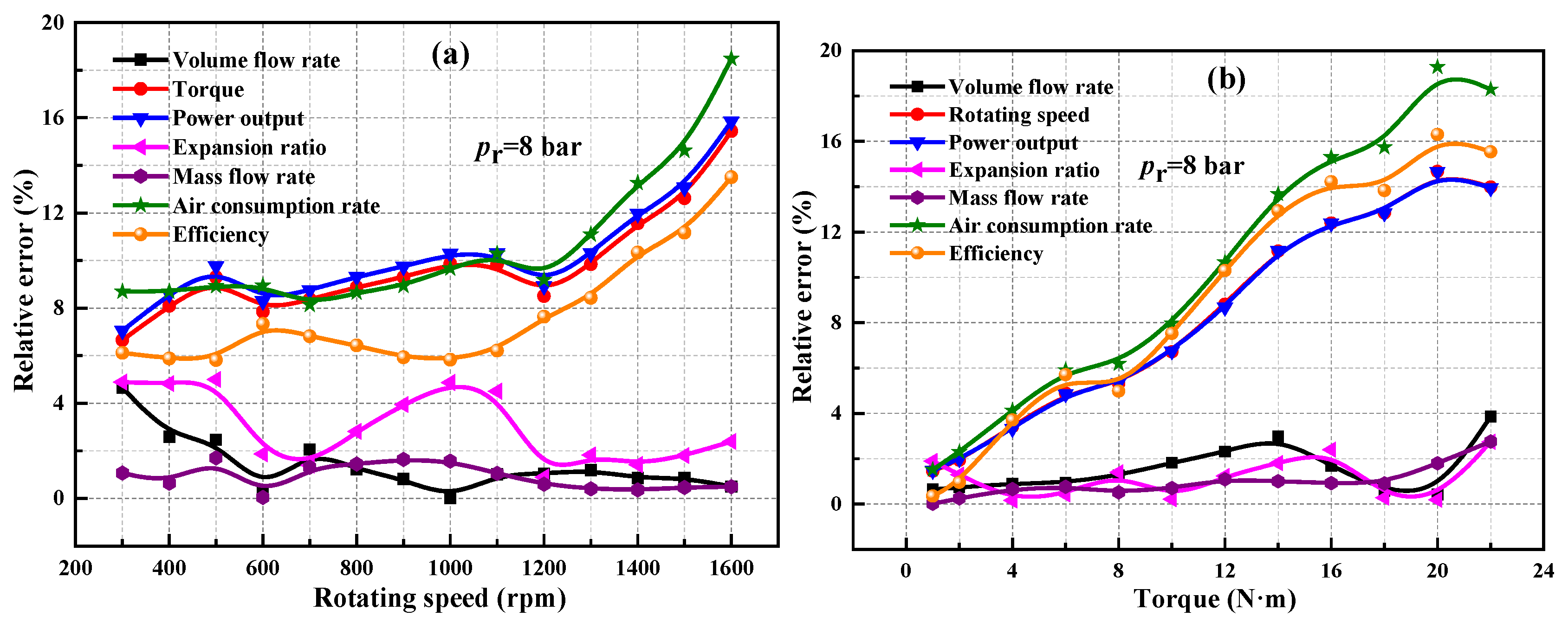

| Rotational Speed (r/min) | 200 | 400 | 600 | 800 | 1000 | 1200 | 1400 | 1600 | 1800 | |
|---|---|---|---|---|---|---|---|---|---|---|
| Torque (N·m) | Reverse | 27.47 | 21.25 | 16.27 | 12.78 | 9.67 | 7.01 | 5.45 | 3.64 | 1.77 |
| Forward | 29.30 | 23.80 | 18.25 | 14.53 | 11.17 | 7.93 | 6.05 | 4.07 | 2.00 | |
| Expansion ratio | Reverse | 6.20 | 5.57 | 4.62 | 4.30 | 3.80 | 3.37 | 3.23 | 3.01 | 2.92 |
| Forward | 8.16 | 5.89 | 4.98 | 4.35 | 3.94 | 3.45 | 3.26 | 3.01 | 2.92 | |
| Power (W) | Reverse | 575.6 | 891.3 | 1022.6 | 1072.7 | 1013.1 | 881.1 | 799.4 | 609.3 | 334.0 |
| Forward | 613.8 | 997.6 | 1147.3 | 1218.1 | 1170.7 | 996.3 | 887.9 | 683.5 | 378.3 | |
| CACR (g/J) | Reverse | 0.301 | 0.184 | 0.154 | 0.139 | 0.137 | 0.151 | 0.161 | 0.205 | 0.361 |
| Forward | 0.257 | 0.160 | 0.132 | 0.122 | 0.119 | 0.129 | 0.142 | 0.178 | 0.310 | |
| Efficiency (%) | Reverse | 2.76 | 4.73 | 6.19 | 7.13 | 7.73 | 7.62 | 7.37 | 6.02 | 3.55 |
| Forward | 2.92 | 5.31 | 6.98 | 8.05 | 8.77 | 8.80 | 8.33 | 6.87 | 4.13 | |
Publisher’s Note: MDPI stays neutral with regard to jurisdictional claims in published maps and institutional affiliations. |
© 2022 by the authors. Licensee MDPI, Basel, Switzerland. This article is an open access article distributed under the terms and conditions of the Creative Commons Attribution (CC BY) license (https://creativecommons.org/licenses/by/4.0/).
Share and Cite
Xu, Y.; Wang, X.; Zhang, H.; Yang, F.; Liang, J.; Yang, H.; Niu, K.; Liu, Z.; Wang, Y.; Wu, Y. Experimental Investigation of the Output Performance of Compressed-Air-Powered Vehicles with a Pneumatic Motor. Sustainability 2022, 14, 15377. https://doi.org/10.3390/su142215377
Xu Y, Wang X, Zhang H, Yang F, Liang J, Yang H, Niu K, Liu Z, Wang Y, Wu Y. Experimental Investigation of the Output Performance of Compressed-Air-Powered Vehicles with a Pneumatic Motor. Sustainability. 2022; 14(22):15377. https://doi.org/10.3390/su142215377
Chicago/Turabian StyleXu, Yonghong, Xin Wang, Hongguang Zhang, Fubin Yang, Jia Liang, Hailong Yang, Kai Niu, Zhuxian Liu, Yan Wang, and Yuting Wu. 2022. "Experimental Investigation of the Output Performance of Compressed-Air-Powered Vehicles with a Pneumatic Motor" Sustainability 14, no. 22: 15377. https://doi.org/10.3390/su142215377
APA StyleXu, Y., Wang, X., Zhang, H., Yang, F., Liang, J., Yang, H., Niu, K., Liu, Z., Wang, Y., & Wu, Y. (2022). Experimental Investigation of the Output Performance of Compressed-Air-Powered Vehicles with a Pneumatic Motor. Sustainability, 14(22), 15377. https://doi.org/10.3390/su142215377








